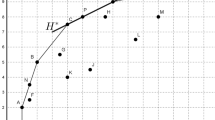Abstract
We present a review of methods for increasing discrimination between efficient DMUs in Data Envelopment Analysis. These methods were classified into two groups: those that incorporate a priori information and those that do not use or minimize the use of such a priori information. We also compare these methodologies regarding their specific characteristics.
Similar content being viewed by others
References
R. Allen, A. Athanassopoulos, R.G. Dyson and E. Thanassoulis, Weights restrictions and value judgements in data envelopment analysis: evolution, development and future directions, Annals of Operations Research 73 (1997) 13-34.
P. Andersen and N.C. Petersen, A procedure for ranking efficient units in data envelopment analysis, Management Science 39 (1993) 1261-1264.
T.R. Anderson, A. Uslu and K.B. Holingsworth, Revisiting extensions in efficiency measurement of alternate machine component grouping solutions via data envelopment analysis, Working paper (1998).
J.E. Beasley, Comparing university departments, Omega International Journal of Management Science 18 (1990) 171-183.
A. Charnes, W.W. Cooper and E. Rhodes, Measuring the efficiency of decision-making units, European Journal of Operational Research 2 (1978) 429-444.
A. Charnes, W.W. Cooper, Z.M. Huang and D.B. Sun, Polyhedral cone-ratio DEA models with an illustrative application to large commercial banks, Journal of Econometrics 46 (1990) 73-91.
A. Charnes, W.W. Cooper, Q.L.Wei and Z.M. Huang, Cone ratio data envelopment analysis and multiple objective linear programming, International Journal of Management Science 20 (1989) 1099-1118.
W.W. Cooper, L.M. Seiford and K. Tone, Data Envelopment Analysis, A Comprehensive Text with Models, Applications, References and DEA-Solver Software (Kluwer, Boston, 2000).
J.R. Doyle and R.H. Green, Efficiency and cross-efficiency in DEA: derivations, meanings and uses, Journal of the Operational Research Society 45 (1994) 567-578.
J.H. Dulá and B.L. Hickman, Effects of excluding the column being scored from the DEA envelopment LP technology matrix, Journal of the Operational Research Society 48 (1997) 1001-1012.
R.G. Dyson and E. Thanassoulis, Reducing weight flexibility in data envelopment analysis, Journal of the Operational Research Society 39 (1988) 563-576.
R. Green, J.R. Doyle and W.D. Cook, Preference voting and project ranking using DEA and crossevaluation, European Journal of the Operational Research 90 (1996) 461-472.
M. Halme and P. Korhonen, Restricting weights in value efficiency analysis, European Journal of Operational Research 126 (2000) 175-188.
M. Halme, T. Joro, P. Korhonen, S. Salo and J. Wallenius, Value efficiency analysis for incorporating preference information in DEA, Management Science 45 (2000) 103-115.
T. Joro, P. Korhonen and J. Wallenius, Structural comparison of data envelopment analysis and multiple objective linear programming, Management Science 44 (1998) 962-970.
P. Korhonen and J. Wallenius, A Pareto race, Naval Research Logistics 35 (1988) 615-623.
P. Korhonen, A. Siljamäki and M. Soismaa, Practical aspects of value efficiency analysis, IIASA Interim report IR-98-042, IIASA, Finland (1998).
P. Korhonen, A. Siljamäki and M. Soismaa, On the use of value efficiency analysis and some further developments, Journal of Productivity Analysis 17 (2002) 49-64.
P. Korhonen, R. Tainio and J. Wallenius, Value efficiency analysis of academic research, European Journal of Operational Research 130 (2001) 121-132.
J.S.M. Kornbluth, Analysing policy effectiveness using cone restricted DEA, Journal of the Operational Research Society 42 (1991) 1097-1104.
X.B. Li and G.R. Reeves, A multiple criteria approach to data envelopment analysis, European Journal of Operational Research 115 (1999) 507-517.
R. Pedraja-Chaparro, J. Salinas-Jimenes, J. and P. Smith, On the role of weight restrictions in DEA, Journal of Productivity Analysis 8 (1997) 215-230.
Y. Roll, W. Cook and B. Golany, Controlling factor weights in DEA, IIE Transactions 23 (1991) 2-9.
L.M. Seiford and J. Zhu, Infeasibility of super efficiency data envelopment analysis models, Information Systems and Operational Research 27 (1999) 174-187.
T.R. Sexton, Measuring Efficiency: An Assessment of Data Envelopment Analysis, ed. R.H. Silkman (Jossey-Bass, San Francisco, 1986).
R.E. Steuer, An interactive multiple objective linear programming procedure, TIMS Studies in the Management Sciences 6 (1977) 225-239.
T.J. Stewart, Relationships between DEA e multicriteria decision analysis, Journal of the Operational Research Society 47 (1996) 654-665.
S. Talluri and J. Sarkis, Extensions in efficiency measurement of alternate machine component grouping solutions via data envelopment analysis, IEEE Transactions on Engineering Management 44 (1997) 27-31.
R.G. Thompson, F.D. Jr. Singleton, R.M. Thrall and B.A. Smith, Comparative site evaluations for locating a high-energy physics lab in Texas, Interfaces 16 (1986) 35-49.
R.M. Thrall, Duality, classification and slacks in DEA, The Annals of Operations Research 66 (1996) 109-138.
Y.-H. Wong and J.E. Beasley, Restricting weight flexibility in DEA, Journal of the Operational Research Society 41 (1990) 829-835.
J. Zhu, Robustness of the efficient DMUs in data envelopment analysis, European Journal of Operational Research 90 (1996) 451-460.
J. Zhu, Data envelopment analysis with preference structure, Journal of the Operational Research Society 47 (1996) 136-150.
J. Zhu, Super-efficiency and DEA sensitivity analysis, European Journal of Operational Research 129 (2001) 443-455.
Author information
Authors and Affiliations
Rights and permissions
About this article
Cite this article
Angulo-Meza, L., Lins, M.P.E. Review of Methods for Increasing Discrimination in Data Envelopment Analysis. Annals of Operations Research 116, 225–242 (2002). https://doi.org/10.1023/A:1021340616758
Issue Date:
DOI: https://doi.org/10.1023/A:1021340616758




